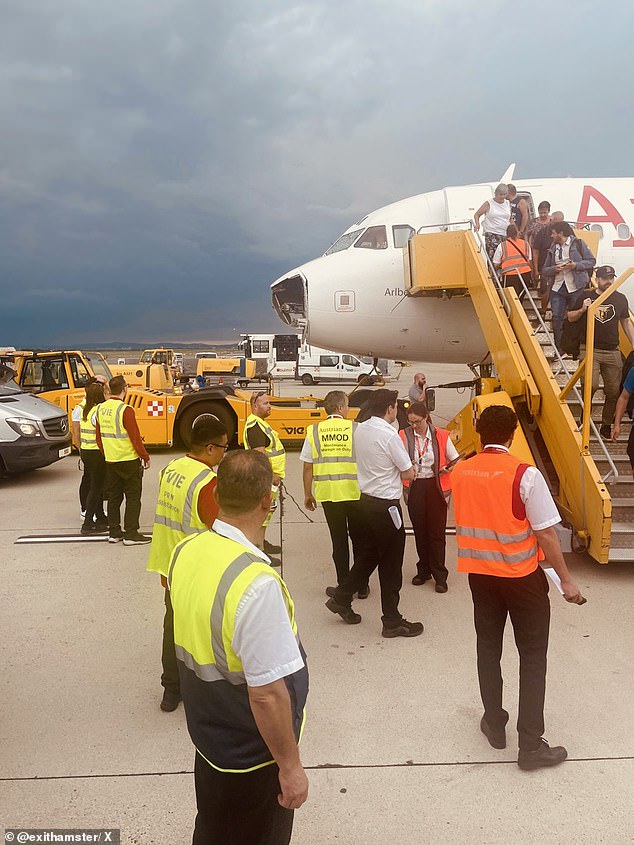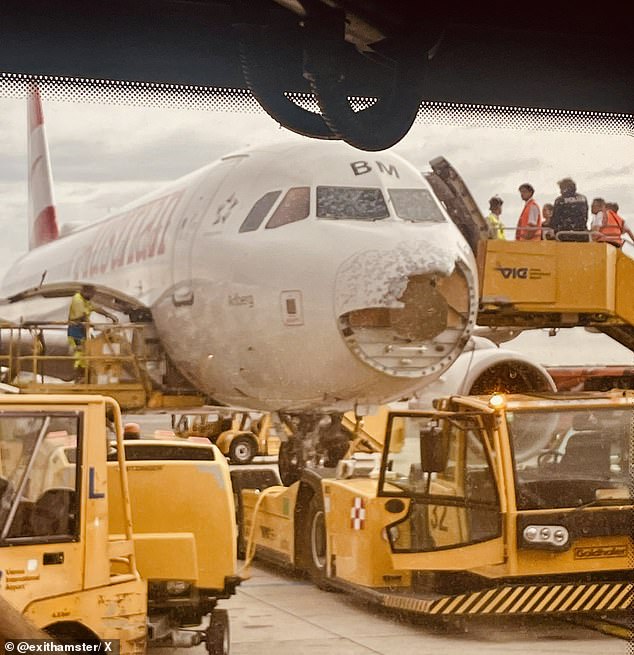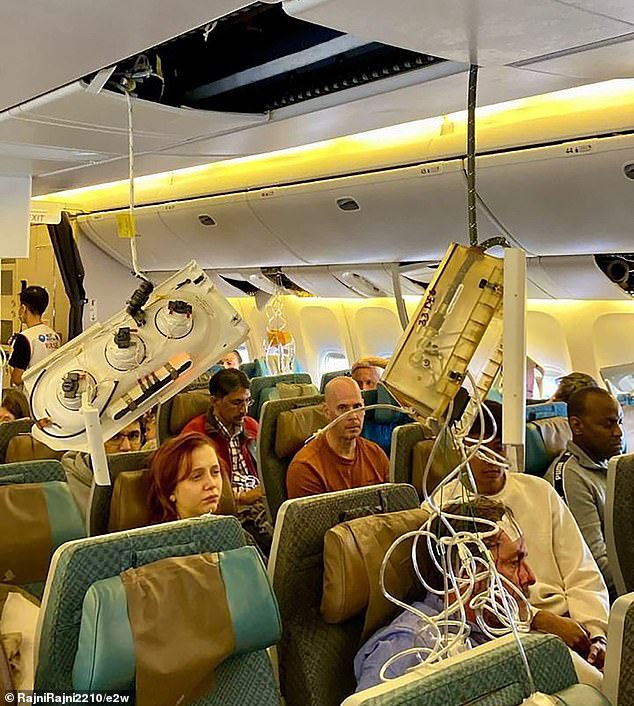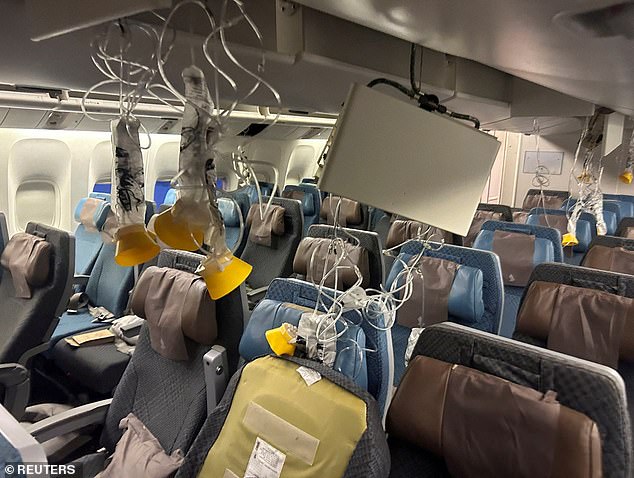Passenger plane miracle as flight from Mallorca manages to land despite hailstones DESTROYING front of plane and shattering cockpit windshield
A passenger plane miraculously landed on Sunday despite hailstones smashing the front of the plane and shattering the cockpit windshield.
Austrian Airlines’ Airbus A320 was flying from Mallorca to Vienna when chunks of ice hit the plane and windshields.
The plane’s pilot was forced to land blind, with the passengers only realizing the true extent of the damage – and barely escaping – after the plane had landed.
After the flight took off from Palma, Mallorca, around 3.30pm on Sunday, the first stages of the flight were uneventful and we experienced light turbulence, passengers said.
However, the airline said the plane flew through a “storm cell” as it approached Vienna and about half an hour before it was due to land.
Austrian Airlines’ Airbus A320 was flying from Mallorca to Vienna when chunks of ice hit the plane and windshields, damaging the nose and windshields

According to the airline, the plane flew through a “storm cell” as it approached Vienna and about half an hour before it was due to land.
Passengers described a ‘violent shaking’ and were alerted by the pilot to the fact that the windshield was broken.
Nevertheless, the plane was able to land in Vienna. The landing was “a bit bumpier than normal,” a passenger told Austrian newspaper Kronen Zeitung.
It was only when the passengers disembarked and walked along the front of the plane that they realized the full extent of the damage.
Photos of the plane show the windshield shattered and the nose of the plane almost completely missing. What is still intact has round spots and dents.
“It was then that the passengers realized that the pilot had landed blind and how close they had come to disaster,” one person told Kronen.
“It could have turned out differently,” said the passenger – who was flying back from Mallorca with a group after celebrating a friend’s 30th birthday.
Austrian Airlines confirmed the incident to the newspaper on Sunday evening.
“On today’s flight OS434 from Palma de Mallorca to Vienna, an Airbus A320 aircraft was damaged by hail,” the airline told Kronen.
It explained that the plane encountered a “thunderstorm cell” as it approached Vienna, and said the flight crew did not see the cell on weather radar.
“According to current information, the two cockpit windows at the front of the aircraft, the nose of the aircraft (radome) and some panels were damaged by the hail,” Kronen reported, citing the airline’s statement.

Passengers described a ‘violent shaking’ and were alerted by the pilot to the fact that the windshield was broken. But it wasn’t until the passengers disembarked and walked along the front of the plane that they realized the full extent of the damage.
Austrian Airlines said a Mayday call was made and emergency services rushed to the airport before the plane landed.
Miraculously, the pilot managed to bring the plane down despite the windshield damage, and everyone on board escaped any injury.
‘The plane was able to land safely at Vienna-Schwechat Airport. All passengers on the flight were unharmed,” the airline told the newspaper.
‘The Austrian Airlines technical team has already been tasked with the specific damage assessment of the aircraft in question. The safety of our passengers and our crews is Austrian Airlines’ top priority.”
The near miss is the latest mid-air incident to make headlines in recent weeks.
Last month, a Singapore Airlines jet encountered severe turbulence, killing one man – 73-year-old Briton Geoffrey Kitchen – and seriously injuring others.
Flight SQ321 experienced massive fluctuations in gravity in less than five seconds, likely causing injuries to people who were not strapped into their seats, according to a Singapore Transport Ministry report released last month.

The near miss is the latest mid-air incident to make headlines in recent weeks. Last month, a Singapore Airlines jet (pictured) was hit by severe turbulence, killing one man – 73-year-old Briton Geoffrey Kitchen – and seriously injuring others.
The plane fell 180 feet (58 meters) in less than a second, which “likely caused the unsecured occupants to become airborne” before falling again, the Department of Transportation said.
The Boeing 777, flying from London to Singapore on May 21, encountered turbulence, throwing people and belongings through the cabin. The plane, with 211 passengers and 18 crew members, made an emergency landing in Bangkok.
While the plane was flying at about 37,000 feet above southern Myanmar, it began to experience mild vibrations due to changes in gravity.
The plane’s altitude increased – likely caused by an updraft and not any action by the pilots – causing the autopilot system to push the plane back to the selected altitude, the report said.
The pilots also noticed an uncontrolled increase in airspeed, which they tried to control by extending panels called speed brakes, and “one pilot shouted that the ‘fasten seat belt’ sign had been engaged.”

Harrowing footage of the aftermath of the incident showed the cabin strewn with debris and oxygen masks hanging from the ceiling. Passengers had desperately tried to staunch the blood flowing from severe cuts and blunt force wounds

A few seconds later, the plane entered a sharp descent, sending unbelted passengers out of their seats before falling back. “This sequence of events likely caused the injuries to the crew and passengers,” the report said.
The pilots turned off the autopilot to stabilize the plane, the report said, and flew it manually for 21 seconds before returning to autopilot.
The plane made a normal, controlled descent and experienced no further turbulence until landing in Bangkok almost an hour later, the ministry said, adding that investigations were ongoing.
Passengers describe the “sheer terror” of the shaking plane, loose objects flying and injured people lying paralyzed on the floor of the plane.
